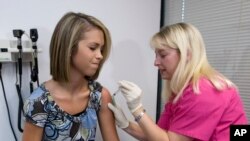Infections of the cancer-causing human papillomavirus, or HPV, have dropped by 64 percent among teenage girls and young women since a vaccine became available a decade ago, according to health officials.
"We are continuing to see decreases in the HPV types that are targeted by the vaccine," said lead researcher Dr. Lauri Markowitz, a medical epidemiologist with the U.S. Centers for Disease Control and Prevention, in an interview with HealthDay.
HPV has been known to cause cervical cancer as well as cancer of the head and neck.
Markowitz cautions that since it takes years for many of these cancers to develop, it will be a while before researchers know how much will be prevented by fewer infections.
"We have seen declines in genital warts [caused by HPV] already," she said. "The next thing we expect to see is a decline in pre-cancers, then later on declines in cancer."
Still, researchers worry that not enough young people are being vaccinated, saying only 22 percent of boys between the ages of 13 and 17 have been vaccinated, while 42 percent of girls in the same age range have been vaccinated.
Researchers said the reason perhaps is that many physicians do not strongly recommend the vaccine because it would require a potentially uncomfortable conversation about sex. The CDC recommends all children get vaccinated by age 12.
"We could see greater declines in HPV-related disease if we had greater coverage," Markowitz said. "A very large percentage of cervical cancers could be prevented by the vaccine."
The CDC researchers used data from the U.S. National Health and Nutrition Examination Surveys to compare rates of HPV infection pre- and post-2006, when the vaccine was made available.
Among girls aged 14-19, the infection rate dropped from 11.5 percent in 2003-2006 to 4.3 percent from 2009-2012. Similar rates of reduction were seen in women aged 20 to 24, showing a drop from 18.5 percent to just above 12 percent, the researchers said.
"HPV vaccine is highly effective," Markowitz said. "We are seeing an impact of vaccination, but coverage rates are still too low. We need to see more coverage to see the full impact of the vaccine."
The report was published online Feb. 22 in the journal Pediatrics.








